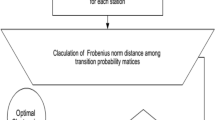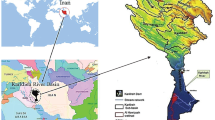Abstract
A detailed regional drought study is carried out in the southern peninsula of India to characterize the spatio-temporal nature of droughts and to predict the drought magnitudes for various probabilities in the homogeneous drought regions. The method of several random initializations of the cluster centres of the K-means algorithm is suggested for the identification of the initial regions in the context of drought regionalization, which is shown to perform better than the initialization from the Ward’s algorithm and the Ward’s algorithm itself. The peninsula is classified into seven spatially well-separated homogeneous drought regions. The robust L-moment framework is used for the regional frequency analysis of drought magnitudes computed using the standardized precipitation index. The Pearson type III is found to be appropriate for regional drought frequency analysis in six of the regions, while the robust Wakeby distribution is suggested for one region. Low magnitude droughts are frequent and dominant in the northern part of west coast, the north-eastern coast and its adjoining inland region, while high magnitude droughts are less in number and are experienced in semi-arid central part, southern part of western coast, south-eastern part and north-western inland region. The spatial maps of drought magnitudes indicate that at higher return periods (100 and 200 years) the south-eastern part of the peninsula is likely to encounter high magnitude droughts, while the central region is likely to experience the same at lower return periods (10 and 50 years). Hence these regions need to be given special importance in the drought mitigation planning activities.








Similar content being viewed by others
References
Bhat GS (2006) The Indian drought of 2002—a sub-seasonal phenomenon? Q J R Meteorol Soc 132:2583–2602
Bonaccorso B, Bordi I, Cancelliere A, Rossi G, Sutera A (2003) Spatial variability of drought: an analysis of the SPI in Sicily. Water Resour Manag 17:273–296
Bordi I, Fraedrich K, Jiang JM, Sutera A (2004) Spatio-temporal variability of dry and wet periods in eastern China. Theor Appl Climatol 79:81–91
Bravar L, Kavvas ML (1991) On the physics of droughts. II Analysis and simulation of the interaction of atmospheric and hydrologic processes during droughts J Hydrol 129(1–4):299–330
Celebi ME, Kingravi HA (2012) Deterministic initialization of the K-means algorithm using hierarchical clustering. Int J Pattern Recognit Artif Intell 26(7):1250018
Dingman SL (2002) Physical hydrology, second edn. Prentice Hall Inc., New Jersey
Gadgil S, Gowri R, Yadumani (1988) Coherent rainfall zones: case study for Karnataka. Proc Indian Acad Sci (Earth Planet Sci) 97(1):63–79
Guttman NB (1999) Accepting the standardized precipitation index: a calculation algorithm. J Am Water Resour Assoc 35:311–322
Hartigan JA, Wong MA (1979) A K-means clustering algorithm. Appl Stat 28:100–108
Hosking JRM (2013) Regional frequency analysis using L-moments. R package, version 2.5. http://CRAN.R-project.org/package=lmomRFA
Hosking JRM, Wallis JR (1993) Some statistics useful in regional frequency analysis. Water Resour Res 29(2):271–281
Hosking JRM, Wallis JR (1997) Regional frequency analysis: an approach based on L-moments. Cambridge University Press, New York
Huang S, Chang J, Huang Q, Chen Y (2014) Spatio-temporal changes and frequency analysis of drought in the Wei River basin, China. Water Resour Manag 28:3095–3110
Jain SK, Agarwal PK, Singh VP (2007) Hydrology and water resources of India. Springer, The Netherlands
Kim TW, Valde JB, Yoo C (2003) Nonparametric approach for estimating return periods of droughts in arid regions. J Hydrol Eng 85:237–246
Kim D-W, Byun H-R, Choi K-S, Oh S-B (2011) A spatiotemporal analysis of historical droughts in Korea. J Appl Meteorol Clim 50:1895–1912
Lee SM, Byun HR, Tanaka HL (2012) Spatiotemporal characteristics of drought occurrences over Japan. J Appl Meteorol Climatol 51:1087–1098
McKee TB, Doesken NJ, Kleist J (1993) The relationship of drought frequency and duration to time scales, paper presented at 8th conference on applied climatology. American Meteorological Society, Anaheim, CA
Mishra AK, Desai VR (2005) Spatial and temporal drought analysis in the Kansabati River basin, India. Int J River Basin Manag 3(1):31–41
Mishra AK, Singh VP (2010) A review of drought concepts. J Hydrol 391(1–2):202–216
Modarres R (2010) Regional dry spells frequency analysis by L-moment and multivariate analysis. Water Resour Manag 24:2365–2380
Naresh Kumar M, Murthy CS, Sesha Sai MVR, Roy PS (2012) Spatiotemporal analysis of meteorological drought variability in the Indian region using standardized precipitation index. Meteorol Appl 19:256–264
Niranjan Kumar K, Rajeevan M, Pai DS, Srivastava AK, Preethi B (2013) On the observed variability of monsoon droughts over India. Weather and Climate Extremes 1:42–50
Nunez JH, Verbist K, Wallis JR, Schaefer MG, Morales L, Cornelis WM (2011) Regional frequency analysis for mapping drought events in north-Central Chile. J Hydrol 405:352–366
Pai DS, Sridhar L, Guhathakurta P, Hatwar HR (2011) District-wide drought climatology of the southwest monsoon season over India based on standardized precipitation index (SPI). Nat Hazards 59:1797–1813
Pandey RP, Ramasastri KS (2001) Relationship between the common climatic parameters and average drought frequency. Hydrol Process 15:1019–1032
Patel R, Chopra P, Dadhwal VK (2007) Analyzing spatial patterns of meteorological drought using standardized precipitation index. Meteorol Appl 14:329–336
Ponce VM, Pandey RP, Ercan S (2000) Characterization of drought across the climatic spectrum. J Hydrol Eng 5(2):222–224
R Core Team (2013) R: A language and environment for statistical computing. R foundation for statistical computing, Vienna, Austria. http://www.R-project.org/
Rad AM, Khalili D (2015) Appropriateness of clustered Raingauge stations for spatio-temporal meteorological drought applications. Water Resour Manag 29:4157–4171
Rajeevan M, Bhate J, Kale JD, Lal B (2005) Development of a high resolution daily gridded rainfall data for the Indian Region (version 2). Meteorol Monogr Climatol 22/2005, India Meteorol Dept, New Delhi
Rao AR, Srinivas VV (2006) Regionalization of watersheds by hybrid-cluster analysis. J Hydrol 318:37–56
Raziei T, Saghafian B, Paulo AA, Pereira LS, Bordi I (2009) Spatial patterns and temporal variability of drought in western Iran. Water Resour Manag 23:439–455
Santos J, Pulido-Calvo I, Portela MM (2010) Spatial and temporal variability of droughts in Portugal. Water Resour Res 46:w03503
Santos JF, Portela MM, Pulido-Calvo I (2011) Regional frequency analysis of droughts in Portugal. Water Resour Manag 25:3537–3558
Steinley D, Brusco MJ (2007) Initialization k-means batch clustering: a critical evaluation of several techniques. J Clasif 24:99–121
Thomas T, Nayak PC, Ghosh NC (2015) Spatiotemporal Analysis of Drought Characteristics in the Bundelkhand Region of Central India using the Standardized Precipitation Index. J Hydrol Eng. doi:10.1061(ASCE)HE.1943-5584.0001189
Tsakiris G, Vangelis H (2005) Establishing a drought index incorporating evapotranspiration. European Water 9(10):3–11
Tsakiris G, Pangalou D, Vangelis H (2007) Regional drought assessment based on the reconnaissance drought index (RDI). Water Resour Manag 21(5):821–833
Tsakiris G, Nalbantis I, Vangelis H, Verbeiren B, Huysmans M, Tychon B, Jacquemin I, Canters F, Vanderhaegen S, Engelen G, Poelmans L, De Becker P, Batelaan O (2013) A system-based paradigm of drought analysis for operational management. Water Resour Manag 27(15):5281–5297
UN (1990) What can be done about drought? International decade for natural disaster reduction. IDNDR Secretariat, Geneva
Vicente-Serrano SM (2006) Spatial and temporal analysis of droughts in the Iberian peninsula (1910–2000). Hydrol Sci 51(1):83–97
Vicente-Serrano SM, Lopez-Moreno JI (2005) Hydrological response to different time scales of climatological drought: an evaluation of the standardized precipitation index in a mountainous Mediterranean basin. Hydrol Earth Syst Sci 9:523–533
Vicente-Serrano SM, Begueria S, Lorenzo-Lacruz J (2010) A multiscalar drought index sensitive to global warming: the standardized precipitation evapotranspiration index. J Clim 23:1696–1718
Ward JH Jr (1963) Hierarchical grouping to optimize an objective function. J Am Stat Ass 58:236–244
Wilhite DA, Svoboda MD (2000) Drought early warning systems in the context of drought preparedness and mitigation. In: Wilhite DA, Sivakumar MVK, Wood DA (eds) Early warning Systems for Drought Preparedness and Drought Management, WMO/TD no, vol 1037. World Meteorological Organization, Geneva, Switzerland, pp. 1–21
Acknowledgments
We wish to thank the Indian Institute of Technology Madras, for providing the necessary facilities for carrying out this research work. We are also thankful to the Editor, the Associate Editor and the two anonymous reviewers for their encouraging comments and constructive suggestions, which were very useful in improving the quality of the manuscript.
Author information
Authors and Affiliations
Corresponding author
Ethics declarations
The manuscript being submitted: has not been published before; is not under consideration for publication anywhere else; has been approved by all co-authors as well as by the responsible authorities. The publisher will not be held legally responsible should there be any claims for compensation.
Rights and permissions
About this article
Cite this article
Ghosh, S., Srinivasan, K. Analysis of Spatio-temporal Characteristics and Regional Frequency of Droughts in the Southern Peninsula of India . Water Resour Manage 30, 3879–3898 (2016). https://doi.org/10.1007/s11269-016-1396-5
Received:
Accepted:
Published:
Issue Date:
DOI: https://doi.org/10.1007/s11269-016-1396-5




